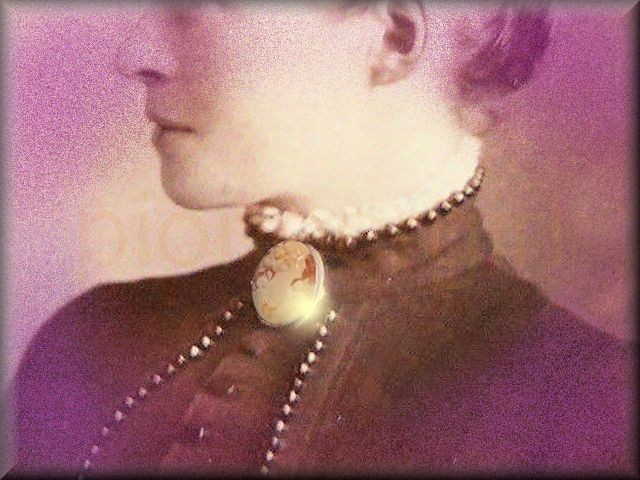cameo

A precious stone carved in relief. Originally the onyx, and afterward the agate, were used for this purpose. In the true cameo, a stone is used having two layers (and sometimes more) of different colors; and the art consists in so cutting as to appropriate these different colors to different parts or elevations of the work. Shells are also used for cheaper work of the same kind. — Webster, 1882
 Aunt Docia’s pretty white collar was fastened in front with a large round cameo pin, which had a lady’s head on it. – Little House in the Big Woods, Chapter 8, “Dance at Grandpa’s”
Aunt Docia’s pretty white collar was fastened in front with a large round cameo pin, which had a lady’s head on it. – Little House in the Big Woods, Chapter 8, “Dance at Grandpa’s”
 At the sugaring-off dance in the Big Woods of Wisconsin, Aunt Docia was described as wearing a dress with buttons up the front that looked like juicy blackberries. She also fastened a cameo pin on her white collar, the round cameo having a lady’s head on it (see Little House on the Prairie, Chapter 8, “Dance at Grandpa’s”). Everybody remembers the buttons, but who remembers the cameo? It’s the only one worn by any character in any Little House book, and it’s only mentioned the one time. No fashion accessories – or even the aunts’ clothes – are mentioned in the Big Woods manuscript or in Pioneer Girl.
At the sugaring-off dance in the Big Woods of Wisconsin, Aunt Docia was described as wearing a dress with buttons up the front that looked like juicy blackberries. She also fastened a cameo pin on her white collar, the round cameo having a lady’s head on it (see Little House on the Prairie, Chapter 8, “Dance at Grandpa’s”). Everybody remembers the buttons, but who remembers the cameo? It’s the only one worn by any character in any Little House book, and it’s only mentioned the one time. No fashion accessories – or even the aunts’ clothes – are mentioned in the Big Woods manuscript or in Pioneer Girl.
According to an 1880 journal, a cameo was an piece carved in high relief, originally restricted to being made of hard banded stone, such as onyx or sardonyx, but later done in shell, lava, or other materials. Typically a figure (such as the lady’s head on Aunt Docia’s pin and the one shown at right) were carved into the center layer, while details were from the top layer, with the darker layer being the ground. The desired piece of stone was first cut into a shape (oval, circle, etc.) and polished, then glued onto a block of wood for stability while carving. A figure was penciled onto the top. Small bits of stone were carved away, leaving the design. The finished piece was polished, then removed from the wooden block and fitted onto a brooch base or ring, for example.
The classical Greek profile cameo was quite popular in the late 19th century because archaeological digs were also popular. Cameos go in and out of fashion and probably always will, but in 1892, “The Collector” (Volume IX, Number 3, page 121) reported that “most people when thinking of cameos say to themselves: ‘Oh, yes, grandma had a cameo brooch, and it was really lovely, but they have gone out of fashion long ago…'”

cameo (BW 8)

